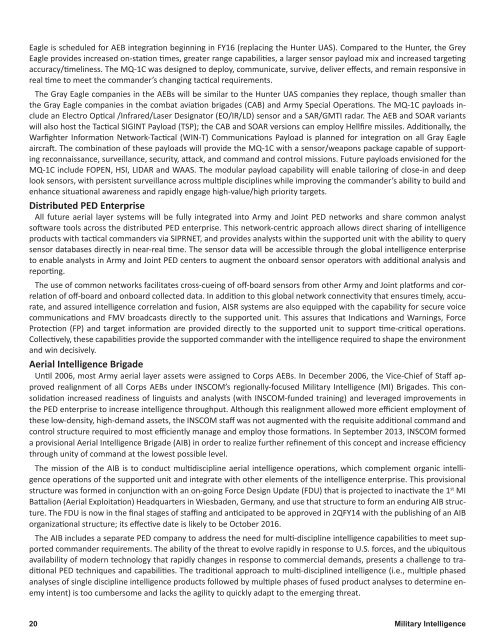2014_01
2014_01
2014_01
You also want an ePaper? Increase the reach of your titles
YUMPU automatically turns print PDFs into web optimized ePapers that Google loves.
Eagle is scheduled for AEB integration beginning in FY16 (replacing the Hunter UAS). Compared to the Hunter, the GreyEagle provides increased on-station times, greater range capabilities, a larger sensor payload mix and increased targetingaccuracy/timeliness. The MQ-1C was designed to deploy, communicate, survive, deliver effects, and remain responsive inreal time to meet the commander’s changing tactical requirements.The Gray Eagle companies in the AEBs will be similar to the Hunter UAS companies they replace, though smaller thanthe Gray Eagle companies in the combat aviation brigades (CAB) and Army Special Operations. The MQ-1C payloads includean Electro Optical /Infrared/Laser Designator (EO/IR/LD) sensor and a SAR/GMTI radar. The AEB and SOAR variantswill also host the Tactical SIGINT Payload (TSP); the CAB and SOAR versions can employ Hellfire missiles. Additionally, theWarfighter Information Network-Tactical (WIN-T) Communications Payload is planned for integration on all Gray Eagleaircraft. The combination of these payloads will provide the MQ-1C with a sensor/weapons package capable of supportingreconnaissance, surveillance, security, attack, and command and control missions. Future payloads envisioned for theMQ-1C include FOPEN, HSI, LIDAR and WAAS. The modular payload capability will enable tailoring of close-in and deeplook sensors, with persistent surveillance across multiple disciplines while improving the commander’s ability to build andenhance situational awareness and rapidly engage high-value/high priority targets.Distributed PED EnterpriseAll future aerial layer systems will be fully integrated into Army and Joint PED networks and share common analystsoftware tools across the distributed PED enterprise. This network-centric approach allows direct sharing of intelligenceproducts with tactical commanders via SIPRNET, and provides analysts within the supported unit with the ability to querysensor databases directly in near-real time. The sensor data will be accessible through the global intelligence enterpriseto enable analysts in Army and Joint PED centers to augment the onboard sensor operators with additional analysis andreporting.The use of common networks facilitates cross-cueing of off-board sensors from other Army and Joint platforms and correlationof off-board and onboard collected data. In addition to this global network connectivity that ensures timely, accurate,and assured intelligence correlation and fusion, AISR systems are also equipped with the capability for secure voicecommunications and FMV broadcasts directly to the supported unit. This assures that Indications and Warnings, ForceProtection (FP) and target information are provided directly to the supported unit to support time-critical operations.Collectively, these capabilities provide the supported commander with the intelligence required to shape the environmentand win decisively.Aerial Intelligence BrigadeUntil 2006, most Army aerial layer assets were assigned to Corps AEBs. In December 2006, the Vice-Chief of Staff approvedrealignment of all Corps AEBs under INSCOM’s regionally-focused Military Intelligence (MI) Brigades. This consolidationincreased readiness of linguists and analysts (with INSCOM-funded training) and leveraged improvements inthe PED enterprise to increase intelligence throughput. Although this realignment allowed more efficient employment ofthese low-density, high-demand assets, the INSCOM staff was not augmented with the requisite additional command andcontrol structure required to most efficiently manage and employ those formations. In September 2<strong>01</strong>3, INSCOM formeda provisional Aerial Intelligence Brigade (AIB) in order to realize further refinement of this concept and increase efficiencythrough unity of command at the lowest possible level.The mission of the AIB is to conduct multidiscipline aerial intelligence operations, which complement organic intelligenceoperations of the supported unit and integrate with other elements of the intelligence enterprise. This provisionalstructure was formed in conjunction with an on-going Force Design Update (FDU) that is projected to inactivate the 1 st MIBattalion (Aerial Exploitation) Headquarters in Wiesbaden, Germany, and use that structure to form an enduring AIB structure.The FDU is now in the final stages of staffing and anticipated to be approved in 2QFY14 with the publishing of an AIBorganizational structure; its effective date is likely to be October 2<strong>01</strong>6.The AIB includes a separate PED company to address the need for multi-discipline intelligence capabilities to meet supportedcommander requirements. The ability of the threat to evolve rapidly in response to U.S. forces, and the ubiquitousavailability of modern technology that rapidly changes in response to commercial demands, presents a challenge to traditionalPED techniques and capabilities. The traditional approach to multi-disciplined intelligence (i.e., multiple phasedanalyses of single discipline intelligence products followed by multiple phases of fused product analyses to determine enemyintent) is too cumbersome and lacks the agility to quickly adapt to the emerging threat.20 Military Intelligence


